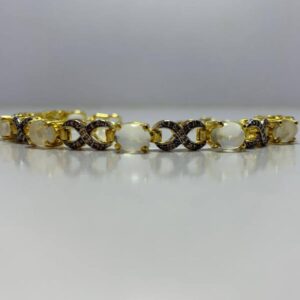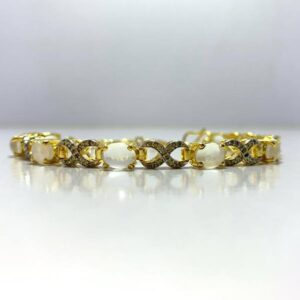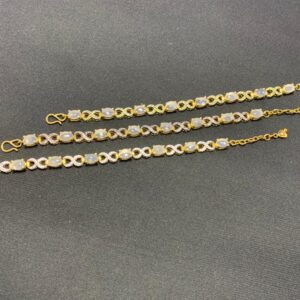Filter by price
-
- Bracelet, Moonstone Bracelet
ROYAL MILKY WHITE MOONSTONE WITH CHAMPAGNE ZIRCONIA TWISTED BRACELET, STERLING SILVER 925 RHODIUM GOLD PLATED
- $ 247.00
- This royal look bracelet is just an eye refresher for an onlooker. It is just a classy choice to wear with any evening outfit. This Sparkling bracelet is studded with oval cut milky white eight moonstones. These gemstones are fixed in sterling silver with claw setting in twisted chain pattern. The sterling silver is rhodium gold plated to make the…
- Add to cart
-
- Bracelet, Moonstone Bracelet
Moon stone with peridot
- $ 247.00
- Moonstone enhances intuition, promotes inspiration, success, and good fortune in love and business matters. Moonstone aids the digestive system, assimilates nutrients, eliminates toxins and fluid retention, and alleviates degenerative conditions of skin, hair, eyes, and fleshy organs such as the liver and pancreas. Known as the stone of compassion, peridot is believed to bring good health, restful sleep, and peace…
- Add to cart
-
- Bracelet, Moonstone Bracelet
ELEGANT MOONSTONE WITH WHITE ZIRCONIA, TWISTED BRACELET, RHODIUM GOLD PLATED
- $ 247.00
- Aileen's original handmade twisted bracelet of moonstone is best to celebrate happiness and gift the loved ones. This masterpiece of bracelet is rhodium gold plated to make it tarnish free and long lasting in use with the same spark and twinkle of 1st day. The bracelet is studded with eight original milky white moonstones with claw setting. Between the moonstones…
- Add to cart
To tone up your look, choose a bracelet adorned with fine stones. These jewels involve gems of all colours, sometimes transparent, sometimes opaque, and which always illuminate your outfit. In our collection of Sterling Silver Moonstone Bracelet, discover models that invite labradorite, a fine stone with a metallic lustre that is enhanced by sparkling silver. Different styles of jewellery are available to you, at a wide price range. Something to please you easily with an original and feminine bracelet.
WHAT IS THE ETYMOLOGY OF THE WORD “MOONSTONE”?
The history of moonstone is very important when we know the attraction and fascination of the moon for our ancestors. Indeed, through the moonstone, they saw a very great resemblance and assimilated it to the clarity of the moon. It is in particular this resemblance to our natural satellite that has earned it the name “Moonstone”. Its white colour and its sometimes glassy and bluish pearly reflections have always fascinated lovers of the night star.
HISTORY OF MOONSTONE
During Antiquity, the moonstone was the object of divination and was considered as the stone of the goddesses. The Romans more particularly associated this stone with Diana, the goddess of the hunt and of the moon. They believed that the Roman goddess of the moon was visible on this stone. At that time, she was already associated with femininity, gentleness and intuition. To receive celestial clairvoyance, some men wore women’s costumes while putting stone in their mouths. By slipping into the skin of women, men could then benefit from all the extraordinary powers of this stone, namely: clairvoyance and spiritual awakening.
As the stone is of a well-known white light, even silvery, the Indian and Roman civilizations believed that the moonstone was created by the rays of it. Even today, this stone is sacred in India. According to the beliefs of the Roman Empire, the moonstone changed the astral phases. Moonstone is also known for its beliefs related to love. This would have the virtue of influencing the feeling of love. During the ancient period, the Greeks used it to protect pregnant women throughout their pregnancy. Associated with fertility and passion, moonstone increased sexual desire and carnal pleasure. This reference to fertility was also present in the Middle East, since the moonstone was used to increase the chances of having a child. Among the Egyptians, the moonstone was a great symbol of protection. Once night has fallen,
Discovered in 1801 by Jean-Claude Delamétherie, moonstone revealed its mysteries as well as all its components at the start of the 19th century. In 2000, the moonstone was officially declared by the state of Florida in the United States, paying homage to the first step on the moon in 1969. Today, the moonstone is widely used to make cabochons, but also jewellery such as moonstone necklace, moonstone bracelet, moonstone pendant, etc. People wear these superb objects and pageantry for their virtues in lithotherapy or simply for fashion. The main moonstone deposits are found in Sri Lanka and Armenia in Lake Sevan. However, it is possible to find other smaller deposits all over the world, for example in Australia, Norway, Germany, Poland, Mexico or Brazil.
ORIGIN AND COMPOSITION OF MOONSTONE
The moonstone comes from the Sanskrit words “kanta”, meaning “beloved” and “chandra”, meaning “moon”. Thus, the two reunited expressions mean “beloved of the moon” referring directly to his mythical origin. Its name also comes from the clarity of the moon, in its splendour and beauty. Moonstone is also nicknamed “hecatolite”, in reference to Hecate, the Greek goddess of the moon and fertility. It is both the symbol of death and rebirth. In fact, there are three Greek goddesses of the moon; Hecate, Artemis and Selene. Together they form “the Lunar Triad”. Moreover, Selene has given its name to another mineral whose milky reflections are reminiscent of those of the Moon. This is the famous selenite.
The Moonstone is a variety of orthosis belonging to the group of silicates, and more precisely to the subgroup of tectosilicates. Its texture is qualified as perthitic. Indeed, moonstone comes from a mixture of two species of feldspar: orthosis and albite. When these two species mix and cool, the mineral reveals accumulated alternate layers. Then, when the light passes through its layers and scatters in several directions, the moonstone produces what is called an adularescence phenomenon. Also known as the Schiller effect, this phenomenon of adularescence produces a gliding reflection on the entire surface of the stone when the latter changes its angle of view.
The moonstone is colourless, but it distinguishes reflections that can range from white to blue, sometimes even to the yellow highlights. The reflections are mainly due to the structure of the moonstone which is crystalline. Its vitreous lustre makes it possible to observe different colours depending on the brightness. On the Mohs scale, the hardness of moonstone varies between 6 and 6.5, while its density is around 2.5. Derived from alkaline, plutonic and metamorphic rocks, this magnificent whitish stone is becoming increasingly rare.
VIRTUES AND BENEFITS OF MOON STONE
The Moon stone has been associated in all cultures with the feminine principle, called Yin in Chinese medicine, like the Moon which is the feminine star, while the Sun symbolizes the masculine principle. It would represent the light which reassures in the darkness.
In lithotherapy, it would therefore have curative properties against female disorders (inconvenience of menopause, infertility, menstrual pain…). It would promote eroticism and marital happiness. It would increase intuition, an essentially feminine quality, as well as gentleness and tenderness, and develop tolerance. It would promote the full development of maternal love and soften the temperament of people who are a little too severe …
Moonstone would bring good luck and reduce the risk of accidents. It would therefore be an asset for travellers.
CHARACTERISTICS OF MOONSTONE
- ORIGIN OF THE NAME: The origin comes from the Sanskrit terms “kanta”, meaning “loved”, and “Chandra”, meaning “moon”.
- MEMBERSHIP GROUP: Feldspars.
- CHEMICAL COMPOSITION: Aluminium potassium double silicate, KAlSi38O8
- CRYSTAL SYSTEM: Monoclinic
- HARDNESS: Between 6 and 6.5
- DEPOSIT (S): Australia, Burma, Brazil, United States, India, Madagascar, Sri Lanka, Tanzania.
- COLOR (S): Colourless, White, bluish, yellow reflections.










